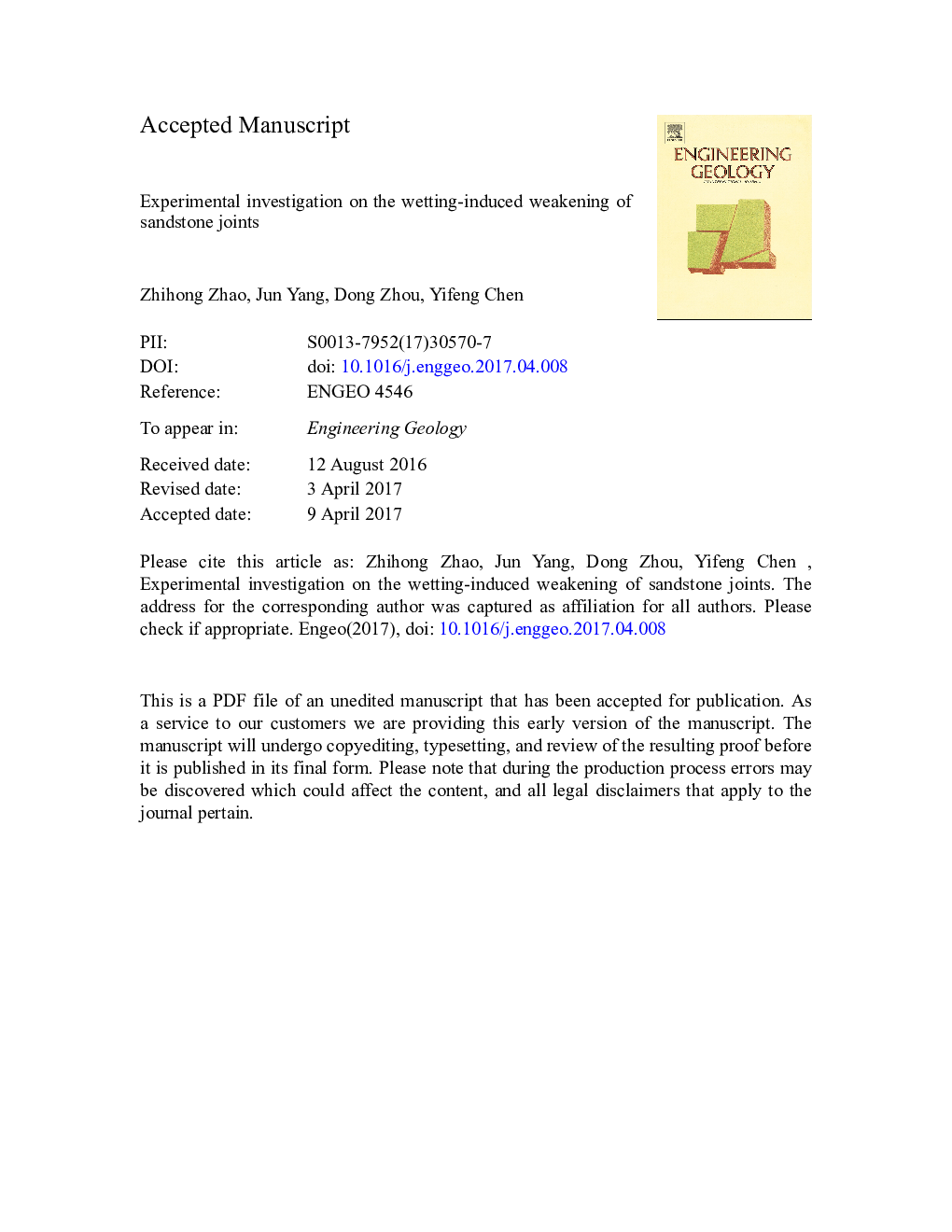| کد مقاله | کد نشریه | سال انتشار | مقاله انگلیسی | نسخه تمام متن |
|---|---|---|---|---|
| 5787562 | 1641760 | 2017 | 30 صفحه PDF | دانلود رایگان |
عنوان انگلیسی مقاله ISI
Experimental investigation on the wetting-induced weakening of sandstone joints
ترجمه فارسی عنوان
بررسی تجربی در مورد تضعیف مایع ماسه سنگ ناشی از خیس شدن
دانلود مقاله + سفارش ترجمه
دانلود مقاله ISI انگلیسی
رایگان برای ایرانیان
کلمات کلیدی
مرطوب کننده مفاصل ماسه سنگ قدرت برشی مشترک، سفتی برشی مشترک، صدمه زخمی،
ترجمه چکیده
اثر آب بر روی رفتار برشی اتصالات در سنگ برای تعیین ثبات سنگ های متصل شده تحت تغییرات در سطوح آب حیاتی است. در این مطالعه، یک سری آزمون مستقیم برشی در مفاصل در نمونه های خشک و مرطوب ماسه سنگی تحت بارهای ثابت ثابت انجام شد تا نفوذ خیس شدن بر روی رفتار برشی مشترک انجام شود. نتایج نشان می دهد که مقاومت برشی پیک از اتصالات ماسه سنگ می تواند از حدود 20 تا 24 درصد به دلیل خیس شدن کاهش یابد، اما کاهش مقاومت برشی برشی ناشی از اشباع احتمالا به طول مدت غوطه وری حساس نیست. رفتار تغییر شکل ماسک سنگی نیز ممکن است تحت تاثیر خیس گذاری قرار گیرد که در آن حرکت جابجایی پیک می تواند افزایش یابد، سختی برشی اتصال می تواند کاهش یابد و جابجایی طبیعی ناشی از برش می تواند از انقباض تا انقباض تغییر یابد. نمونه ی ساده ی ساده شیب سنگ شیب دار برای نشان دادن نقش خیس شدن در کاهش عامل ایمنی استفاده شد. این مثال نشان داد که تنها با توجه به اثر مکانیکی فشار منفذ، اما نادیده گرفتن تضعیف ناشی از رطوبت ناشی از مفاصل سنگ ممکن است پایداری شیب را بیش از حد تعیین کند و برای مهندسی عمر سنگین بسیار خطرناک باشد.
موضوعات مرتبط
مهندسی و علوم پایه
علوم زمین و سیارات
مهندسی ژئوتکنیک و زمین شناسی مهندسی
چکیده انگلیسی
The effect of water on the shear behavior of joints in rock is critical for determining the stability of jointed rocks subjected to changes in water levels. In this study, a series of direct shear tests on joints in dry and wet sandstone samples were conducted under constant normal loads to investigate the influence of wetting on joint shear behavior. The results show that the peak shear strength of sandstone joints can be lowered by about 20%-24% owing to wetting, but the saturation-induced reduction of joint shear strength is probably not sensitive to the duration of immersion. The deformation behavior of sandstone joints can also be affected by wetting in that peak shear displacement can increase, joint shear stiffness may be reduced, and shear-induced normal displacement may switch from dilation to contraction. A simplified hypothetical example of a steep rock slope was used to demonstrate the role of wetting in lowering the factor of safety. This example indicated that only considering the purely mechanical effect of pore pressure, but neglecting the wetting-induced weakening of rock joints may overestimate the slope stability and be highly risky for practical rock engineering.
ناشر
Database: Elsevier - ScienceDirect (ساینس دایرکت)
Journal: Engineering Geology - Volume 225, 20 July 2017, Pages 61-67
Journal: Engineering Geology - Volume 225, 20 July 2017, Pages 61-67
نویسندگان
Zhihong Zhao, Jun Yang, Dong Zhou, Yifeng Chen,
